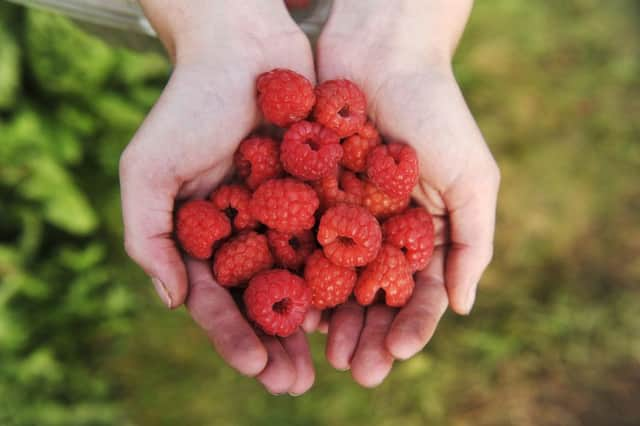Scots scientists working towards improving flavour of the raspberry


The flavour of the fragile fruit is particularly susceptible to changes in the environment with shoppers also divided on what makes a good raspberry.
Research has shown men, women and the young and old all have differing views on what a raspberry should taste like with the popularity of the fruit struggling as a result.
Advertisement
Hide AdAdvertisement
Hide AdNow, scientists from the James Hutton Institute at Invergowrie, near Dundee, are researching how to breed a raspberry that holds on to its flavour whatever the weather while appealing to as many people as possible.
Dr Julie Graham, soft fruit scientist and project leader at the James Hutton Institute, said that being able to release raspberries that both taste good and are resilient to environmental stress was key to the success of the soft fruit industry, which is worth around £115m a year in Scotland.
Dr Graham said: “If a consumer buys raspberries that they don’t like, some won’t go back and buy the fruit for the rest of the season. Others won’t go back for several weeks. A negative eating experience does have a big impact on purchasing. We also want to understand why the environment has such a big effect on the flavour.”
The institute will now devise a more sophisticated system to indicate to farmers the right time to pick the fruit that will take in a more detailed range of factors than currently used.
It will also research how the genetics of the raspberry plant respond to changes in the environment.
Dr Graham added: “Things like sugar are so crucial to the metabolism of the plant. If it is a bad season and there is not enough light about, the plant is not going to put in all that extra effort into tasting good.
“The plant is making all these decisions and we want to know when the plant is making these decisions.”
New Zealand firm Delytics Ltd is now working with the Angus-based research team to get the best raspberries to meet the taste expectations of consumers.
Advertisement
Hide AdAdvertisement
Hide AdDr Graham said research on how shoppers rate raspberries had delivered some “complex” results.
She said: “Typically, the younger you are, the sweeter you want your raspberries. As people get older, they tend to want a balance between sugar and acid. Then there is also a gender divide. Speaking generally, men tend to like a bit of balance and then women like it sweeter. However, that again is affected by age profile. It is really quite interesting what people want in flavour.”
Raspberry crops in Scotland cover around a third of land given over to strawberries, according to Scottish Government figures.
Strawberry crops in Scotland rose by 5.7 per cent to 990 hectares between 2015 and 2016 with the increase largely driven by the amount of fruit grown under cover.
Meanwhile, raspberries which, in recent years have been affected by reduced demand and disease such as raspberry root rot, continued a long-term trend of decline with coverage falling by seven per cent to 325 acres.
In 2016, strawberries worth £84 million were grown in Scotland and accounted for 73 per cent of the overall value of soft fruit. Raspberries were valued at £12 million.
Dr Graham said: “Raspberries are much more fragile than strawberries. All these wee drupelets they have are actually individual fruits. Just think of how much effort goes in to having all these drupelets growing at the same time. They are tricky to grow but they are worth it. They are just a pleasure.”